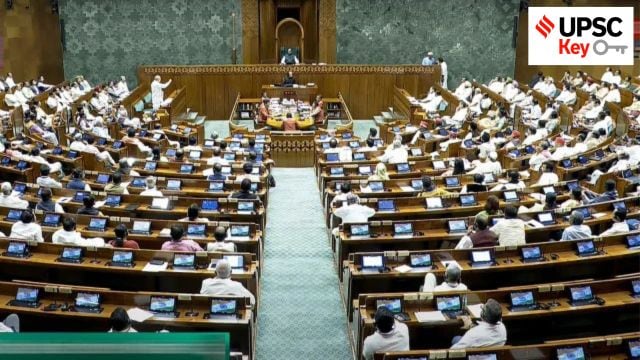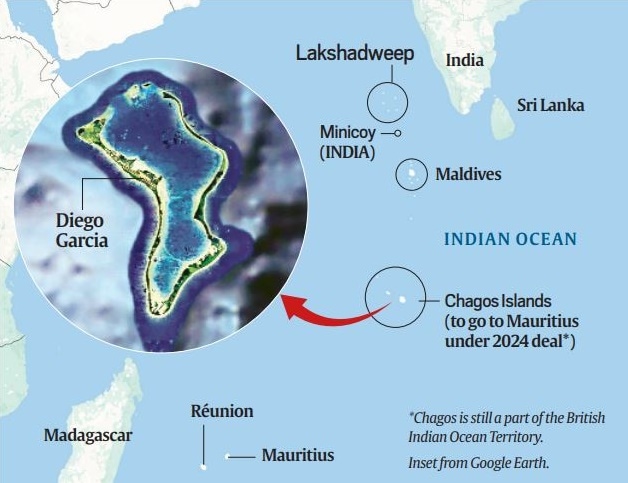UPSC Key: UMEED Bill, Poverty estimation in India and Groundwater Contamination
Why Unified Management Empowerment Efficiency and Development (UMEED) Bill is relevant to the UPSC exam? What is the significance of topics such as decline in India’s 10-year bond yields, Classifications of poverty and Chagos Archipelago on both the preliminary and main exams? You can learn more by reading the Indian Express UPSC Key for April 3, 2025.
 UPSC Key April 2025: Here's what you should be reading from the April 3, 2025 edition of The Indian Express
UPSC Key April 2025: Here's what you should be reading from the April 3, 2025 edition of The Indian Express Important topics and their relevance in UPSC CSE exam for April 3, 2025. If you missed the April 2, 2025 UPSC CSE exam key from the Indian Express, read it here
THE WORLD
UK and Mauritius close in on Chagos deal after US consent
Syllabus:
Preliminary Examination: Current events of national and international importance.
Main Examination: General Studies II: Effect of policies and politics of developed and developing countries on India’s interests
What’s the ongoing story: Britain and Mauritius are finalizing a deal to transfer sovereignty over the Chagos Islands, a disputed U.K. territory that is home to a major U.S. military base, the U.K. government said.
Key Points to Ponder:
• Map Work-Chagos Archipelago
• Why Chagos Islands has long been the subject of a dispute between Mauritius and the UK?
• Why the Chagos Archipelago is strategically important?
• UK-Mauritius Agreement-Know in detail
• The case of Chagos reflects the unfinished legacy of colonialism—Discuss
• What role can India play in resolving the Chagos Archipelago dispute between the UK and Mauritius?
Key Takeaways:
• The government signaled that President Donald Trump’s administration, which was consulted on the deal, has given its approval and no further action is needed from the U.S.
• Britain and Mauritius have been negotiating a deal for the U.K. to hand over the Indian Ocean archipelago, which is home to a strategically important naval and bomber base on the largest of the islands, Diego Garcia. The U.K. would then lease back the base for at least 99 years.
• But the deal has faced criticism from the opposition Conservative Party and from some allies of Trump. Last year the now-Secretary of State Marco Rubio said it posed “a serious threat” to U.S. national security.
• Britain split the islands away from Mauritius, a former British colony, in 1965, three years before Mauritius gained independence, and called the Chagos archipelago the British Indian Ocean Territory.
• In the 1960s and 1970s Britain evicted up to 2,000 people from the islands so the U.S. military could build the Diego Garcia base.
• Mauritius has long contested Britain’s claim to the archipelago and in recent years the United Nations and its top court have urged Britain to return the Chagos to Mauritius.
• Britain agreed to do so in a draft deal in October, but that has been delayed by a change of government in Mauritius and reported quarrels over how much the U.K. should pay for the lease of the Diego Garcia air base
• The Chagos islanders, many of whom relocated to Britain, say they were not consulted over the agreement. Under the draft deal, a resettlement fund would be created to help displaced islanders move back to the islands, apart from Diego Garcia. Details of any such measures remain unclear.
Do You Know:
• The Chagos archipelago comprises more than 60 low-lying islands in the Indian Ocean roughly 1,600 km to the northeast of the main island of Mauritius.
Chagos has a land area of only 56.1 sq km, with Diego Garcia alone spread over 32.5 sq km — which is about the same as the land area of Lakshadweep.
 Diego Garcia and Chagos.
Diego Garcia and Chagos.
• Including the lagoons within its atolls, however, Chagos has a total area of more than 15,000 sq km. The Great Chagos Bank, spread over 12,642 sq km, is the world’s largest atoll structure. (An atoll is a ring-shaped coral reef, island, or series of islets, which surrounds a body of water called a lagoon.)
• Although it finds mention in some Maldivian oral traditions, Chagos was uninhabited for most of its history. The islands are far from any other piece of inhabited land — its closest inhabited neighbour Addu, the southernmost Maldivian atoll, lies 500 km away — and have scant resources to support settled populations.
The Portuguese visited and mapped out Chagos in the 16th century, and used the islands as a stopover in voyages around the Cape of Good Hope to India. But it was only in the 18th century that the first permanent settlements emerged on the islands.
• France became the first European power to officially plant its flag on Chagos, when it claimed the Peros Banhos island in 1744. The French had earlier set up Indian Ocean colonies in Île Bourbon (now Réunion) in 1665, Isle de France (now Mauritius) in 1715, and the Seychelles in 1744.
• In 1783, a Mauritius-based plantation-owner named Pierre Marie Le Normand founded a settlement in the previously uninhabited Diego Garcia. He brought 22 slaves from Mauritius to Chagos, who became the islands’ first permanent inhabitants. These slaves likely traced their origins to Madagascar and East Africa, and were put to work in the coconut plantations in the island.
• By 1786, a number of fishing settlements and coconut plantations had been established on the islands. The labour for these enterprises was supplied by slaves from Mauritius, the Seychelles, Madagascar, and East Africa.
• In 1814, after the fall of the Napoleonic French Empire, France formally ceded Mauritius, including Chagos, and the Seychelles to Great Britain. After Britain abolished slavery in its colonies in 1833, indentured labour from India and Malaya was brought to the plantations.
• The Chagossian population today traces its origins to freed African slaves, and the Indian and Malayan labourers who arrived in the 18th and 19th centuries. Under international law, they are the indigenous people of the Chagos archipelago.
• In 2017, the UN General Assembly voted to ask the International Court of Justice to examine the legal status of the archipelago. In 2019, the ICJ concluded that “the UK is under an obligation to bring to an end its administration of the Chagos Archipelago as rapidly as possible”.
• The UNGA subsequently adopted a resolution welcoming the ICJ’s ruling, and demanded that the UK “unconditionally withdraw its colonial administration from the area within six months”.
But negotiations between the UK and Mauritius began only in 2022. A deal was struck in October 2024. Britain recognised Mauritius’ claim over all of Chagos, including Diego Garcia — however, the deal said that the UK would, for a 99-year initial period, exercise “the sovereign rights [over Diego Garcia] and authorities of Mauritius are required to ensure the continued operation of the base well into the next century”.
Other Important Articles Covering the same topic:
📍UK-Mauritius treaty on Chagos Archipelago, Diego Garcia: What it means, why it matters for India
FRONT PAGE
Waqf Bill clears Lok Sabha storm: Govt cites transparency, Opp says bid to divide on faith
Syllabus:
Preliminary Examination: Indian Polity and Governance-Constitution, Political System, Panchayati Raj, Public Policy, Rights Issues, etc.
Main Examination: General Studies II: Government policies and interventions for development in various sectors and issues arising out of their design and implementation.
What’s the ongoing story: The contentious Waqf (Amendment) Bill, which proposes sweeping changes in regulation of Waqf properties and settlement of disputes, sailed through Lok Sabha after a midnight vote Wednesday, capping a marathon 12-hour debate in which the Opposition accused the BJP-led NDA government of interference in Muslim religious affairs in contravention of the Constitution, a charge rejected by Union Home Minister Amit Shah who said the Bill had no provision for government interference.
Key Points to Ponder:
• What is a Waqf Property?
• Know the historical background of Waqf.
• What is Waqf Act 1995?
• Waqf Amendment Bill 2025 which is renamed as UMEED Bill—what are the key provisions and highlights of the bill?
• How Waqf Amendment Bill 2025 is different from Waqf Act 1995?
• Why Waqf (Amendment) Bill to be called as Unified Management Empowerment Efficiency and Development (UMEED) Bill?
• Waqf Amendment Bill 2025 has sparked significant controversy and criticism since its introduction in the Lok Sabha—Why it is been criticised from many scholars and opposition leaders?
• Why Section 40 of the Waqf Act is the most controversial?
Key Takeaways:
• Hitting back at Opposition parties which united in accusing the government of targeting the beliefs and practices of the Muslim community, Shah said the government had no intention to interfere in the affairs of the community.
• Both Shah and Minority Affairs Minister Kiren Rijiju, who spoke at the beginning of the debate and replied to it before the voting, said the proposed reforms would ensure the welfare of poor Muslims and women.
• Making an intervention during the debate, Shah said non-Muslims in the waqf council and boards are meant purely for ensuring administration of properties in accordance with stated aims.
• Rijiju, who tabled the Bill, said, “We have allowed Shia, Sunni, backward Muslims, women and expert non-Muslims to be part of the Waqf Board…. There can be four non-Muslims in it. And there have to be two women. Look at the Waqf Boards until now. Where are the women?”
• The Bill amends the Waqf Act,1995, which governs the management of Waqf properties in India. It proposes sweeping changes which give the government a foot in the door in regulating Waqf properties, and settling disputes regarding such properties.
• The Bill was first introduced in August last year, and referred to a House panel headed by BJP MP Jagdambika Pal. On February 27, the panel, in a 15-11 vote, cleared 14 amendments, all moved by BJP members or its allies in the National Democratic Alliance.
Do You Know:
• The primary objection to the Waqf Bill, 2025 is framed in questioning the need for bringing a new law that changes the way Waqfs are managed.
—Asaduddin Owaisi of the All-India Majlis-e-Ittehadul Muslimeen (AIMIM) has said that the Bill’s objective is to weaken the foundations of Waqf governance and to undermine the rights of Muslims.
—Government officials say that the 1995 Act contains some loopholes with regard to the regulation of Waqf properties including title disputes, and the illegal occupation of Waqf land, which has prompted the Centre to bring a fresh law.
—Also, the lack of judicial oversight on Waqf management is a key issue, according to officials. Questions concerning Waqf properties are heard by the Waqf Tribunal whose decisions cannot be challenged in court.
—The Bill is also being brought at a time when the constitutional validity of the Waqf Act is under challenge before the Delhi High Court.
• A major criticism of the opponents of the Bill is that it gives the government a handle to regulate the management of Waqf properties, and the power to determine whether a property is a Waqf.
—Section 40 of the Waqf Act empowers the Waqf Board to decide if a property is Waqf property. —The decision of the Board would be final unless it is revoked or modified by the Waqf Tribunal.
The Bill extends this power, which currently lies with the Waqf Tribunal, to the District Collector.
—The Bill also states that until the government makes a decision, the disputed property will be treated as a government property and not a Waqf property.
• The government’s intention behind bringing this crucial change is the alleged misuse of Waqf laws, sources said. According to government officials, Section 40 of the Waqf Act is “widely misused to declare private properties as Waqf properties, causing legal battles and unrest”.
• In Islamic law, the dedication of a property as Waqf was done largely verbally until documentation became the standard norm. For example, even in the absence of a Waqfnama, a masjid can be deemed to be Waqf property if it is continuously used as such.
—The amendments also seek to remove the concept of “Waqf by use”, which means that a property can be deemed to be a Waqf through use as a Waqf, even if the original declaration is suspect. The Bill, by omitting the provisions relating to the “Waqf by user,” makes a Waqf property suspect in the absence of a valid Waqfnama.
• The 1995 Act prescribes a survey of auqaf (plural of waqf) by a Survey Commissioner appointed by the state government. The amendment Bill replaces the Survey Commissioner with the District Collector or any other officer not below the rank of a Deputy Collector duly nominated by the Collector. It is learnt that the government’s reasoning for this change is that survey work has been poor in several states. Officials said that in Gujarat and Uttarakhand, surveys have not yet begun, while a survey ordered in Uttar Pradesh in 2014 is still pending.
• Another criticism of the Bill is that it changes the representation of Waqf Boards
—The Bill proposes allowing a non-Muslim Chief Executive Officer, and at least two non-Muslim members to be appointed by the state government to the Waqf Boards at the state level. Critics of the Bill argue that this could interfere with the community’s right to manage its own affairs, a constitutionally protected right.
—On the issue of having non-Muslim representation in the Waqf Board, government officials argue that the move is aimed at bringing expertise and promotes transparency without undermining community representation. While there will be non-Muslim members on the Board, they will not form the majority, government sources said.
• The Bill proposes to delete Section 107 of the 1995 law that had made the Limitation Act, 1963 inapplicable to Waqf properties.
—The Limitation Act is a statutory bar on individuals from filing cases after a period of time. Essentially, this provision ensured that the Waqf Board is not limited by the statutory timeframe of 12 years to file a case to reclaim its properties from encroachment.
Other Important Articles Covering the same topic:
📍Bid to make us second-class citizens: Owaisi leads Opp minority MPs’ attack
📍Muslim bodies plan to approach court, launch nationwide protest
GOVT & POLITICS
‘Fostering’ unity, ‘deterring’ offences: Uttarakhand govt’s arguments for UCC
Syllabus:
Preliminary Examination: Indian Polity and Governance
Main Examination:
• General Studies II: Indian Constitution—significant provisions etc.
• General Studies II: Government policies and interventions for development in various sectors and issues arising out of their design and implementation.
What’s the ongoing story: National integration and gender equality, the need to pre-empt criminal offences, and protection of children born out of live-in relationships — these are some of the major arguments that the State’s counter affidavit has put forth in response to a clutch of petitions challenging the Uniform Civil Code in the Uttarakhand High Court, The Indian Express has learnt.
Key Points to Ponder:
• Uniform Civil Code (UCC) in Uttarakhand-What you know so far?
• The history of the Uniform Civil Code (UCC) pitch in Uttarakhand-How it started?
• Uniform Civil Code of Uttarakhand Act, 2024-Know key features and highlights
• Uniform Civil Code of Uttarakhand Act, 2024-Know issues and controversies
• How does the Uttarakhand UCC align with the constitutional provisions related to the Uniform Civil Code (UCC)?
• Know how the government’s stance on a uniform civil code (UCC) has evolved between the year 1991 to 2004?
• What are arguments for implementing Uniform Civil Code in India?
• What constitutional experts saying in this regard?
• How does Uttarakhand Uniform Civil Code impact personal laws in the state?
• Examine the sociological implications of implementing a Uniform Civil Code in Uttrakhand
Key Takeaways:
• According to sources familiar with the matter, the affidavit from the Union of India and the state government argues that the right to privacy is not absolute and that the framers of the Constitution — including visionaries such as Dr B R Ambedkar — recognised the UCC as a necessity in fostering national unity and integrity.
• It also cites cases such as the 1985 Shah Bano Begum case for maintenance, the 2019 Jose Paulo Coutinho verdict where Goa was cited as a “shining example” of UCC, and the UN General Assembly Convention on elimination of discrimination against women to bolster its arguments on the need for the law – including mandatory to registration of marriage and live-in relationships.
• The affidavit was in response to five petitions challenging the provisions of the Uniform Civil Code of Uttarakhand Act, 2024, and the rules under the law.
Do You Know:
• Aimed at regulating aspects such as marriage, divorce, inheritance, adoption, and property succession, the Uniform Civil Code of Uttarakhand Act, 2024, was passed in February last year, with the rules under it coming into effect this January. According to the government, the rules were meant to codify a disparate set of personal laws that govern these aspects but critics argue that it violates privacy and opens vulnerable couples to unwarranted scrutiny — even the risk of violence.
• The Code defines live-in relationships as a relationship in the “nature of marriage” between a man and a woman cohabiting in a shared household, and requires compulsory registration of live-in relationships through a “statement of live-in relationship”.
A live-in relationship may be terminated by either of the parties to the live-in relationship by submitting a “statement of termination”.
Failure to register a live-in relationship within one month of entering into the relationship has been criminalised, with punishment up to
three months in jail or fine not exceeding Rs 10,000.
• One striking feature of the Code is that it abolishes the coparcenary system, which exists under Hindu personal law.
• To the extent that the Code leaves out most LGBT persons from its ambit, it is a missed opportunity to follow through on the Supreme Court’s decision in the marriage equality matter, wherein it had clarified that state legislatures are competent to ensure marriage equality for all.
Other Important Articles Covering the same topic:
📍Uttarakhand civil code: The key changes for Hindus and Muslims in marriage, inheritance
📍Hits and misses of Uttarakhand Uniform Civil Code: What the Bill does, and does not do
Previous year UPSC Prelims Question Covering similar theme:
1. A legislation that confers on the executive or administrative authority an unguided and uncontrolled discretionary power in the matter of the application of law violates which one of the following Articles of the Constitution of India? (2021)
(a) Article 14
(b) Article 28
(c) Article 32
(d) Article 44
2. Consider the following provisions under the Directive Principles of State Policy as enshrined in the Constitution of India: (2012)
1. Securing for citizens of India a uniform civil code
2. Organising village Panchayats
3. Promoting cottage industries in rural areas
4. Securing for all the workers reasonable leisure and cultural opportunities
Which of the above are the Gandhian Principles that are reflected in the Directive Principles of State Policy?
(a) 1, 2 and 4 only
(b) 2 and 3 only
(c) 1, 3 and 4 only
(d) 1, 2, 3 and 4
UPSC Previous Year Mains Question Covering similar theme:
📍Discuss the possible factors that inhibit India from enacting for its citizens a uniform civil code as provided for in the Directive Principles of State Policy. (2015)
THE IDEAS PAGE
Syllabus:
Preliminary Examination: Economic and Social Development-Sustainable Development, Poverty, Inclusion, Demographics, Social Sector Initiatives, etc.
Mains Examination:
• General Studies I: Poverty and developmental issues, urbanization, their problems and their remedies.
• General Studies II: Issues relating to poverty and hunger
• General Studies III: Inclusive growth and issues arising from it
What’s the ongoing story: Shamika Ravi Writes: India’s economic growth as well as government welfare programmes have been widely inclusive, their impact on minorities and vulnerable groups has been substantial. Poverty has come down among all communities.
Key Points to Ponder:
• What is Poverty?
• How poverty is defined by different international institutions??
• What has the Multidimensional Poverty Index stated about India’s poverty levels?
• Classifications of poverty-Know in Detail (Hint: Absolute and Relative)
• Poverty estimation in India-How Poverty is defined in India?
• Alagh Committee (1979) Lakdawala Committee (1993), Tendulkar Committee (2009), Rangarajan committee (2012) and their poverty estimation.
• What do you understand by the term ‘head-count ratio’?
• What do understand by Private Final Consumption Expenditure (PFCE) and Government Final Consumption Expenditure (GFCE)?
• What is poverty line basket?
• What does the basket of goods include?
• Poverty Alleviation Programs in India by Government of India
• What is the current “level” of poverty in India?
• Why are poverty numbers important?
Key Takeaways:
Shamika Ravi Writes:
• Democracy is not merely about free and fair elections or the peaceful transfer of power. In principle and practice, it is also about how the elected political leaders cater to the needs of the marginal and the vulnerable sections of society, irrespective of whether these social or religious groups vote for them.
• In this essay, we wish to quantitatively assess the performance of this government in the context of poverty reduction among social and religious groups from 2011-12 to 2023-24.
• Poverty not only deprives an individual of basic necessities, but also denies people a life of dignity. Worse still, poverty remains one of the greatest barriers to social upliftment.
• First, it is essential to briefly discuss how we measure poverty. We use the poverty line for 2011-12 for each state and Union Territory (UT), which the expert group under C Rangarajan recommended in 2014
• It is crucial to mention that the Government of India did not officially accept this poverty line.
• For 2023–24, we use the state and UT level data on the Consumer Price Index for each component in estimating the Rangarajan poverty line and update the state and UT poverty lines accordingly for 2023–24.
—Overall, the estimates reveal a remarkable decline in poverty across India in the last 12 years. In rural areas, poverty declined from 30.4 per cent to 3.9 per cent, while in urban areas, it declined from 26.4 per cent to 3.9 per cent. A similar magnitude of decline has been documented by Surjit Bhalla and Karan Bhasin.

• There is a significant decrease in poverty among religious groups in the country, in particular, the two largest groups — Hindus and Muslims.
• This essay has assessed poverty reduction across major religious and social groups of India, using unit-level data from nationally representative surveys of households in 2011-12 and 2023-24.
Do You Know:
• Poverty can be defined as a condition in which an individual or household lacks the financial resources to afford a basic minimum standard of living. Economists and policymakers estimate “absolute” poverty as the shortfall in consumption expenditure from a threshold called the “poverty line”. The official poverty line is the expenditure incurred to obtain the goods in a “poverty line basket” (PLB). Poverty can be measured in terms of the number of people living below this line (with the incidence of poverty expressed as the head count ratio). The “depth” of poverty indicates how far the poor are below the poverty line.
• Six official committees have so far estimated the number of people living in poverty in India — the working group of 1962; V N Dandekar and N Rath in 1971; Y K Alagh in 1979; D T Lakdawala in 1993; Suresh Tendulkar in 2009; and C Rangarajan in 2014. The government did not take a call on the report of the Rangarajan Committee.
Other Important Articles Covering the same topic:
Previous year UPSC Prelims Question Covering similar theme:
3. In a given year in India, official poverty lines are higher in some States than in others because (2019)
(a) poverty rates vary from State to State
(b) price levels vary from State to State
(c) Gross State Product varies from State to State
(d) quality of public distribution varies from State to State
Previous year UPSC mains Question Covering similar theme:
📍Though there have been several different estimates of poverty in India, all indicate reduction in poverty levels over time. Do you agree? Critically examine with reference to urban and rural poverty indicators (2015)
EXPRESS NETWORK
‘Excess fluoride’ in Sonbhadra groundwater: Residents say they are getting sicker
Syllabus:
Preliminary Examination: Current events of national and international importance.
Mains Examination: General Studies III: Conservation, environmental pollution and degradation, environmental impact assessment.
What’s the ongoing story: The issue of excess fluoride in Sonbhadra’s groundwater was first discovered in 2013, when a sample from Padarach village was sent off for testing after multiple residents complained of health issues.
Key Points to Ponder:
• What is fluoride used for?
• What are the primary causes of fluoride contamination in groundwater in India?
• Discuss the socio-economic implications of fluoride contamination in rural India.
• Water contamination in India is a major environmental and health concern—Examine
• What are the challenges in implementing water purification and safe drinking water schemes in fluoride-affected regions?
• Why groundwater is one of our most precious resources?
• What are the other reasons for groundwater contamination?
• What are the Issues with Groundwater Management in India?
• What is the Current Situation of Groundwater in India?
Key Takeaways:
• The Sonbhadra, UP’s second-largest district, where rich deposits of granite, an igneous rock, have leached “excess” fluoride into the groundwater, making it unfit for human consumption. It’s a problem that the government has taken note of, most recently in a March report by the state water authority, the Jal Nigam.
• Mahendra Singh, the Executive Engineer at the Jal Nigam, Sonbhadra, who was recently transferred to Lucknow, told The Indian Express that the report confirmed the presence of “excessive” fluoride in the groundwater in 120 hamlets, home to nearly 2 lakh people, across the district.
• Confirming Vijay Kumar’s fluorosis diagnosis, Sonbhadra Chief Medical Officer (CMO) Dr Ashwani Kumar says, “Fluorosis is not fatal. In the elderly, it can cause joint pain, stiffness, bone deformities, mobility issues, muscle weakness and fatigue. In children, the most common sign is yellow stains on the teeth.”
• Before the launch of the Har Ghar Jal Yojana, under the Jal Jeevan Mission in 2019, schemes to provide treated water to the public were launched by the Jal Nigam in 2012-13, says DM Badrinath Singh.
• Meanwhile, administration officials say steps have been taken since 2013 to supply potable water to Padarach village after the contamination was first discovered. They said plans were also made to supply treated surface water from rivers, lakes, and ponds.
Do You Know:
• Called the ‘energy capital of India’, Sonbhadra shares its borders with Madhya Pradesh, Chhattisgarh, Jharkhand and Bihar. Officials said five sectors in the district — Dudhi, Myorpur, Babhani, Kone and Chopan — are especially rich in granite deposits.
• Located around 50 km from the district headquarters, Padarach village, which has 300 residents, is among the worst-hit by fluorosis. Most village residents, who live in houses made of mud, are engaged in farming. The locals say they still depend on borewells and hand pumps to meet their potable water needs.
• The locals say they have been advised to avoid boiling groundwater since “boiling increases fluoride concentration”. They say they have also been encouraged to consume lemon and tamarind regularly to reduce the impact of fluoride on their body.
Other Important Articles Covering the same topic:
📍Highest fluorine contamination in groundwater in Rajasthan; Jaisalmer worst-affected in India: study
Previous year UPSC Prelims Question Covering similar theme:
4. Which of the following can be found as pollutants in the drinking water in some parts of India? (2013)
1. Arsenic
2. Sorbitol
3. Fluoride
4. Formaldehyde
5. Uranium
Select the correct answer using the codes given below.
a) 1 and 3 only
b) 2, 4 and 5 only
c) 1, 3 and 5 only
d) 1, 2, 3, 4 and 5
Previous year UPSC Mains Question Covering similar theme:
What are the salient features of the Jal Shakti Abhiyan launched by the Government of India for water conservation and water security? (UPSC CSE 2020)
ECONOMY
Benchmark 10-year bond yields decline sharply ahead of RBI’s policy review
Syllabus:
Preliminary Examination: Economic and Social Development
Main Examination: General Studies III: Indian Economy and issues relating to planning, mobilization, of resources, growth, development and employment.
What’s the ongoing story: Ahead of the Reserve Bank of India’s monetary policy review on April 9 and US President Donald Trump’s new tariff policy, India’s benchmark 10-year bond yields on Wednesday fell sharply by nine basis points (bps) to 6.49 per cent on a year-on-year after the central bank announced it would buy Rs 80,000 crore worth of bonds in April.
Key Points to Ponder:
• What is the bond yield in India?
• What is the difference between interest rate and bond yield?
• Know the relationship between bond yields, interest rates, and inflation.
• How does change in RBI’s monetary policy impact bond yields?
• Why there is a decline in India’s 10-year bond yields?
• Discuss the role of government securities (G-Secs).
• How does the US Federal Reserve impact India’s bond yields and overall economic stability?
Key Takeaways:
• When bond yield — the return an investor can expect to earn until maturity — falls, bond prices go up. While a decline in bond yields generally suggests that markets are expecting lower interest rates in the future, it doesn’t necessarily guarantee or lead to a fall in interest rates in the near future.
• Closely following the trajectory of US bond yields, Indian bond yields have fallen 24 bps since March, after the RBI cut the repo rate by 25 bps in the February policy review. For the financial year 2024-25, the 10-year yield has plunged 62 bps so far, its biggest drop in five years.
• The 10-year US Treasury notes’ yield decreased to 4.15 per cent on April 1 and to 4.12 per cent on April 2 morning, marking the lowest level since December 6, 2024. This decline is attributed to investors seeking safer assets ahead of Trump’s anticipated tariff announcement on Wednesday.
• The comfortable liquidity situation as seen by a slight deficit last week has ensured that India’s bond yields have come down, said an analyst. The cut-offs for all the three Treasury bills have come down to almost the same at 6.30 per cent. The 10-year bond yield is likely to go down further depending on the state of liquidity.
• The RBI’s monetary policy is coming up. There is speculation of various options being implemented this time: a cut in Cash Reserve Ratio (CRR), change in stance to accommodative, and a 25-50 bps cut in repo rate.
Do You Know:
• According to the Investopedia, a bond yield is the return an investor realizes on a bond. Put simply, a bond yield is the return on the capital invested by an investor. Bond yields are different from bond prices—both of which share an inverse relationship. The yield matches the bond’s coupon rate when the bond is issued. Bond yields can be derived in different ways, including the coupon yield and current yield. Additional calculations of a bond’s yield include yield to maturity (YTM) among others.
• A bond is a debt instrument in which an investor loans money to an entity (typically corporate or government) which borrows the funds for a defined period of time at a variable or fixed interest rate. Bonds are used by companies, municipalities, states and sovereign governments to raise money to finance a variety of projects and activities. Owners of bonds are debt holders, or creditors, of the issuer.
• A Government Security (G-Sec) is a tradeable instrument issued by the Central Government or the State Governments. It acknowledges the Government’s debt obligation. Such securities are short term (usually called treasury bills, with original maturities of less than one year) or long term (usually called Government bonds or dated securities with original maturity of one year or more). In India, the Central Government issues both, treasury bills and bonds or dated securities while the State Governments issue only bonds or dated securities, which are called the State Development Loans (SDLs). G-Secs carry practically no risk of default and, hence, are called risk-free gilt-edged instruments.
• Treasury bills or T-bills, which are money market instruments, are short term debt instruments issued by the Government of India and are
presently issued in three tenors, namely, 91 day, 182 day and 364 day. Treasury bills are zero coupon securities and pay no interest.
• Dated G-Secs are securities which carry a fixed or floating coupon (interest rate) which is paid on the face value, on half-yearly basis. Generally, the tenor of dated securities ranges from 5 years to 40 years.
Other Important Articles Covering the same topic:
📍Explained: Bonds, yields, and inversions
📍Explained: What rise in bond yield means for investors, government
Previous year UPSC Prelims Question Covering similar theme:
5. Consider the following statements: (2018)
1. The Reserve Bank of India manages and services Government of India Securities but not any State Government Securities.
2. Treasury bills are issued by the Government of India and there are no treasury bills issued by the State Governments.
3. Treasury bills offer are issued at a discount from the par value.
Which of the statements given above is/are correct?
(a) 1 and 2 only
(b) 3 only
(c) 2 and 3 only
(d) 1, 2 and 3
EXPLAINED
Syllabus:
Preliminary Examination: General issues on Environmental ecology, Bio-diversity and Climate Change – that do not require subject specialization.
Mains Examination: General Studies III: Conservation, environmental pollution and degradation, environmental impact assessment.
What’s the ongoing story: This summer is likely to be extremely warm. In its latest forecast for the coming months, the India Meteorological Department (IMD) has predicted an “above-normal number of heatwave days” over most parts of the country.
Key Points to Ponder:
• What is a heat wave?
• Indian Meteorological Department (IMD) criteria for Heat Waves?
• What is the present situation of Heat Waves in India?
• What are the major causes and impacts of heatwaves in India?
• How climate change is influencing the frequency and intensity of heatwaves?
• How effective are India’s Heat Action Plans (HAPs) in mitigating heatwave-related disasters?
• Discuss the role of urban planning in heatwave mitigation.
• How can Indian cities be made more resilient to extreme heat conditions?
Key Takeaways:
• The forecast is in line with the general trend of summer heat becoming more intense, and heatwaves occurring with greater frequency. This has implications for people’s health, particularly that of poor and vulnerable groups, and has economic impacts, including income loss.
• Unlike some other consequences of climate change, the impacts of heatwaves can be largely managed, if timely actions are initiated. Several states, and cities, have prepared heat action plans to deal with heatwaves and soften their impact on the people. However, several reports have pointed out in recent years that their implementation has not been adequate.
• The IMD has said during the April to June summer season, “above normal” heatwave days are expected in practically the entire northern, central and eastern India. The extreme south, the northeastern region, Jammu & Kashmir, and Himachal Pradesh are the only regions that might escape exceptional heat this summer.
• The ‘normal’ number of heatwave days varies from state to state. Rajasthan, for example, is expected to have eight to 12 heatwave days during the summer season in a normal year. However, in 2024, eastern Rajasthan experienced 23 heatwave days, while western Rajasthan had 29. Similarly, Uttar Pradesh is expected to get 10-12 days of heatwaves but had 32 last year.
 Number of heatwave days in recent years in India.
Number of heatwave days in recent years in India.
• The year 2024 was particularly bad. Every state in the country, except Nagaland, Manipur, Mizoram, and Tripura, experienced a heatwave. Even Kerala recorded six days of heatwave conditions during the summer season. The year saw a total of 554 heatwave days across the country — a sum of heatwave days in all the states — which was the highest in the last 15 years. The year 2010 had recorded 578 heatwave days.
Do You Know:
• Heatwaves are concentrated periods of abnormally high temperatures, usually over relatively smaller areas. The annual temperature is the average of temperatures over the entire country or region over the year. Incidentally, 2024 was the warmest year on record, both for the world and for India as well. However, there is no direct correlation between the number of heatwave days during a season and the average annual temperature.
• The likely number of heatwave days in the coming season cannot be predicted with much confidence, but the fact that the frequency and intensity of heatwaves in India are rising has been established by several studies.
• One recent study, ‘Heat waves in India: patterns, associations, and sub-seasonal prediction skills’ by Raju Mandal and colleagues at the Indian Institute of Tropical Meteorology in Pune, has mapped the heatwave trends over the country in the last seven decades.
• Published in the journal Climate Dynamics, the study found that instances of heatwaves in central, northwest and southeast regions of the country had been growing at the rate of about three heatwave days per decade since 2000. The increase was more pronounced, in relative terms, in the southeastern coastal region that includes Odisha, and parts of Andhra Pradesh, Telangana and Chhattisgarh.
• The IMD puts out fairly accurate forecasts, alerting states, and districts, five to seven days in advance about an impending heatwave. Unlike extreme rainfall which are highly localised events, heatwaves are spread over relatively large areas and are easily captured in weather models, leading to better forecasts.
Other Important Articles Covering the same topic:
📍Mercury soaring in parts of country: How a ‘heatwave’ is defined and measured, what makes it worse
Previous year UPSC Prelims Question Covering similar theme:
6. What are the possible limitations of India in mitigating global warming at present and in the immediate future? (2010)
1. Appropriate alternate technologies are not sufficiently available.
2. India cannot invest huge funds in research and development.
3. Many developed countries have already set up their polluting industries in India.
Which of the statements given above is/are correct?
(a) 1 and 2 only
(b) 2 only
(c) 1 and 3 only
(d) 1, 2 and 3
Previous year UPSC Main Question Covering Similar Theme:
📍Bring out the causes for the formation of heat islands in the urban habitat of the world. (2013)
|
PRELIMS ANSWER KEY |
|
1. (a) 2.(b) 3.(b) 4.(c) 5.(c) 6.(a) |
For any queries and feedback, contact priya.shukla@indianexpress.com
Subscribe to our UPSC newsletter. Stay updated with the latest UPSC articles by joining our Telegram channel – IndianExpress UPSC Hub, and follow us on Instagram and X.
Must Read
Buzzing Now
Apr 09: Latest News
- 01
- 02
- 03
- 04
- 05



























